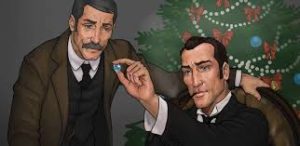Lord Chi Wen thought three times before taking any action. When the Master heard this, he said: “Twice is plenty enough.”
According to David Bentley Hart
“Fortuitous” does not mean “fortunate.” It means “by chance” or “unanticipated”; and if your dictionary tells you that it may also be used to mean “fortunate,” then your dictionary is a scented and brilliantined degenerate in a glossy lavender lounge suit who intends to teach your children criminal ways while you are away at the grocery.
According to Confucius
Never give a sword to a man who can’t dance.
According to C.S. Lewis
The Real is that which says to us, “Your preferences have not been considered.”
The Adventure of the Blue Carbuncle
Though Arthur Conan Doyle sold his first Sherlock Holmes story in 1887 to Beeton’s Christmas Annual, “Adventure of the Blue Carbuncle” is the only account of the great detective which deals with Christmas. We learn, in this short piece written for the January 1892 edition of the Strand Magazine, how a battered hat and a Christmas goose lead Holmes to the solution of a mystery, the freeing of an innocent man and the recovery of a giant blue jewel.
According to Samuel Johnson
A man had rather have a hundred lies told of him than one truth which he does not wish should be told.
According to Confucius
To be wealthy and honored in an unjust society is a disgrace.
According to David Bentley Hart
It is a truth universally acknowledged that it is only a short road that leads from grammatical laxity to cannibalism.
Twelve Days of Christmas
In 567 the Council of Tours proclaimed the twelve days between Christmas and Epihany to be a sacred and festive season. Since then it has been widely accepted as a time of holiday and merriment; in many times and places all non-essential work was forbidden. In German-speaking territories the time is Die Zwölf Raunächte, the Twelve Rough Nights, a time to take precautions against the evil spirits (especially the sky-borne Wild Hunt) with noise, masks and smoke.
The Twelve Days are not calculated in the same way everywhere. In some places Christmas is counted making Epiphany the thirteenth day. In England it is particularly confusing because January 6 is Twelfth Day but January 5 is Twelfth Night.
According to Confucius
If language is not correct, then what is said is not what is meant; if what is said is not what is meant, then what must be done remains undone; if this remains undone, morals and art will deteriorate; if justice goes astray, the people will stand about in helpless confusion. Hence there must be no arbitrariness in what is said. This matters above everything.


